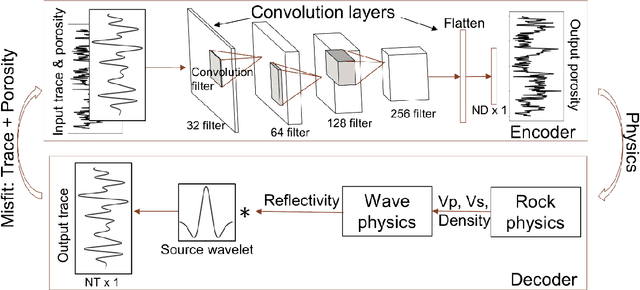Divakar Vashisth
Seismic inversion using hybrid quantum neural networks
Mar 06, 2025



Abstract:Quantum computing leverages qubits, exploiting superposition and entanglement to solve problems intractable for classical computers, offering significant computational advantages. Quantum machine learning (QML), which integrates quantum computing with machine learning, holds immense potential across various fields but remains largely unexplored in geosciences. However, its progress is hindered by the limitations of current NISQ hardware. To address these challenges, hybrid quantum neural networks (HQNNs) have emerged, combining quantum layers within classical neural networks to leverage the strengths of both paradigms. To the best of our knowledge, this study presents the first application of QML to subsurface imaging through the development of hybrid quantum physics-informed neural networks (HQ-PINNs) for seismic inversion. We apply the HQ-PINN framework to invert pre-stack and post-stack seismic datasets, estimating P- and S-impedances. The proposed HQ-PINN architecture follows an encoder-decoder structure, where the encoder (HQNN), processes seismic data to estimate elastic parameters, while the decoder utilizes these parameters to generate the corresponding seismic data based on geophysical relationships. The HQ-PINN model is trained by minimizing the misfit between the input and predicted seismic data generated by the decoder. We systematically evaluate various quantum layer configurations, differentiation methods, and quantum device simulators on the inversion performance, and demonstrate real-world applicability through the individual and simultaneous inversion cases of the Sleipner dataset. The HQ-PINN framework consistently and efficiently estimated accurate subsurface impedances across the synthetic and field case studies, establishing the feasibility of leveraging QML for seismic inversion, thereby paving the way for broader applications of quantum computing in geosciences.
DispersioNET: Joint Inversion of Rayleigh-Wave Multimode Phase Velocity Dispersion Curves using Convolutional Neural Networks
Oct 21, 2023Abstract:Rayleigh wave dispersion curves have been widely used in near-surface studies, and are primarily inverted for the shear wave (S-wave) velocity profiles. However, the inverse problem is ill-posed, non-unique and nonlinear. Here, we introduce DispersioNET, a deep learning model based on convolution neural networks (CNN) to perform the joint inversion of Rayleigh wave fundamental and higher order mode phase velocity dispersion curves. DispersioNET is trained and tested on both noise-free and noisy dispersion curve datasets and predicts S-wave velocity profiles that match closely with the true velocities. The architecture is agnostic to variations in S-wave velocity profiles such as increasing velocity with depth and intermediate low-velocity layers, while also ensuring that the output remains independent of the number of layers.
Direct Estimation of Porosity from Seismic Data using Rock and Wave Physics Informed Neural Networks (RW-PINN)
Sep 30, 2022



Abstract:Petrophysical inversion is an important aspect of reservoir modeling. However due to the lack of a unique and straightforward relationship between seismic traces and rock properties, predicting petrophysical properties directly from seismic data is a complex task. Many studies have attempted to identify the direct end-to-end link using supervised machine learning techniques, but face different challenges such as a lack of large petrophysical training dataset or estimates that may not conform with physics or depositional history of the rocks. We present a rock and wave physics informed neural network (RW-PINN) model that can estimate porosity directly from seismic image traces with no or limited number of wells, with predictions that are consistent with rock physics and geologic knowledge of deposition. As an example, we use the uncemented sand rock physics model and normal-incidence wave physics to guide the learning of RW-PINN to eventually get good estimates of porosities from normal-incidence seismic traces and limited well data. Training RW-PINN with few wells (weakly supervised) helps in tackling the problem of non-uniqueness as different porosity logs can give similar seismic traces. We use weighted normalized root mean square error loss function to train the weakly supervised network and demonstrate the impact of different weights on porosity predictions. The RW-PINN estimated porosities and seismic traces are compared to predictions from a completely supervised model, which gives slightly better porosity estimates but poorly matches the seismic traces, in addition to requiring a large amount of labeled training data. In this paper, we demonstrate the complete workflow for executing petrophysical inversion of seismic data using self-supervised or weakly supervised rock physics informed neural networks.
 Add to Chrome
Add to Chrome Add to Firefox
Add to Firefox Add to Edge
Add to Edge